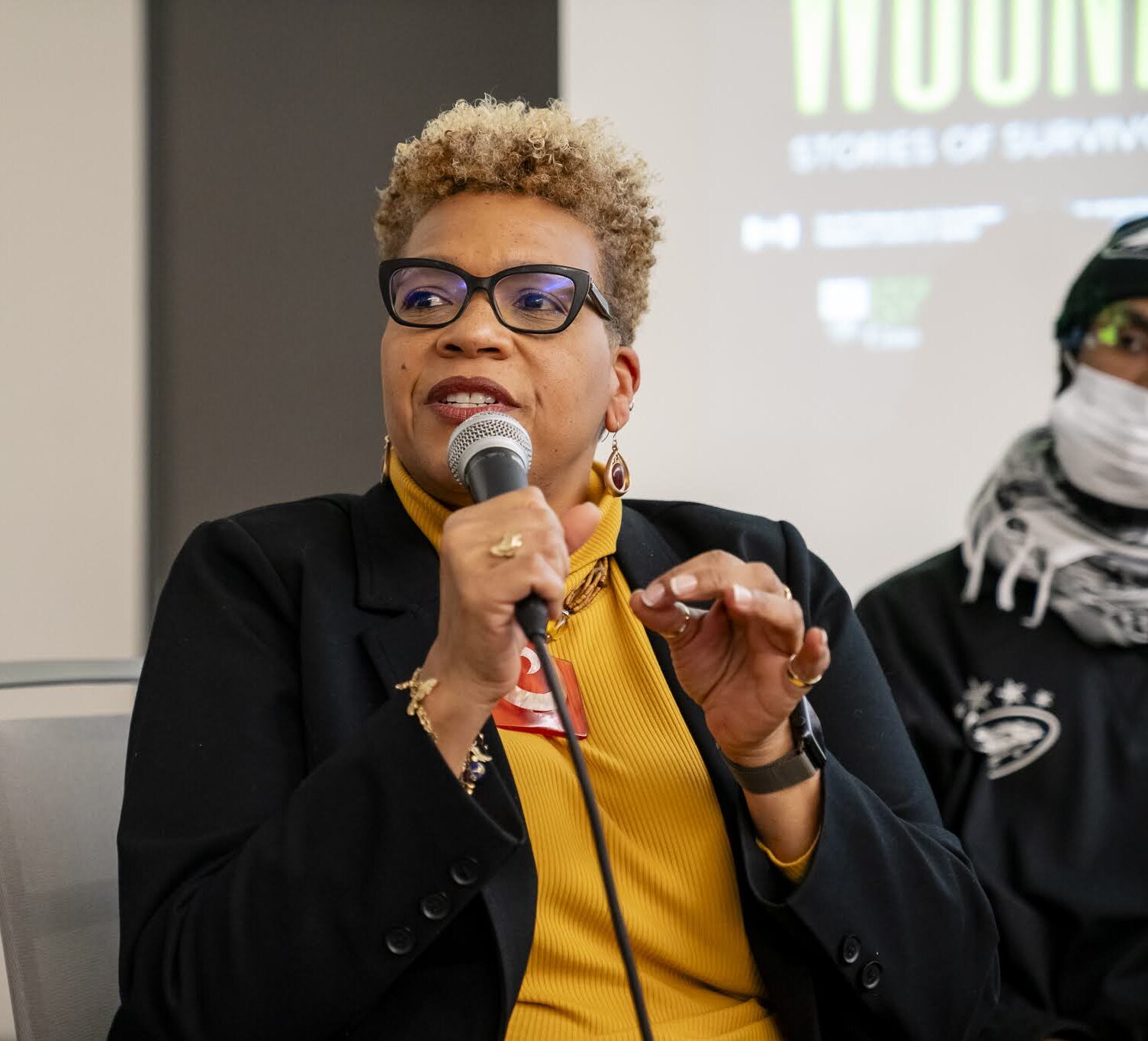How culturally responsive research can help prevent the root causes of homicide impacting Black communities
Categories: Research, Students, Tanya Sharpe FIFSW’s fall campaign aims to accelerate the impact of its research and students. PhD student Elo Igor is working with The CRIB to chart new ways forward for and with Black communities impacted by violence. Learn how you can support research and emerging scholars engaged in this preventative work.
FIFSW’s fall campaign aims to accelerate the impact of its research and students. PhD student Elo Igor is working with The CRIB to chart new ways forward for and with Black communities impacted by violence. Learn how you can support research and emerging scholars engaged in this preventative work.
After graduating with her Master of Social Work, Elo Igor (MSW 2019) served as a case worker at a non-profit organization, supporting young people in correctional facilities on firearm-related charges as they transitioned back to the community.
Listening to their stories, she recognized a distressing gap in support. In one case, a young man had experienced a major shooting in his community and was expected to get back to school and hand in homework as usual.
“Nobody had asked him, ‘How are you feeling today? How did that impact you?’ It was business as usual. Just, go back home, hand in that assignment, and if somebody bothers you, you can’t respond or react, because then you become the problem,” says Igor.
While she notes that every case is nuanced and complex, through her work Igor began to see the school-to-prison pipeline of young Black men in action — and she was determined to intervene.
Igor is now pursuing her PhD in social work, researching access to school-based mental health services for Black youth who have been exposed to community violence. She is also a project coordinator for the Centre for Research & Innovation for Black Survivors of Homicide Victims (The CRIB), where she helps advance collaborative and culturally responsive research, policy and practice. Based at the Factor-Inwentash Faculty of Social Work, The CRIB works across disciplines in collaboration with communities to create innovative culturally attuned prevention and intervention strategies designed to meet the needs of Black communities plagued by homicide.
The power of school-based support
Reflecting on her own school experience, Igor knows first-hand what a difference the right support can make for Black kids during their formative years.
“I have very vivid memories of being this young person in the education system and feeling these forces that were constantly up against me, but also encountering amazing bright lights — teachers and school staff who supported me and saw strength and potential, even when I didn’t see it myself,” says Igor.
She remembers when she was in grade eight, a group of teachers was talking openly in the hallway about her and how she was not going to succeed in life. She had been in the girls’ bathroom and heard everything. But then one educator saw potential in her and encouraged her through her academic pursuits.
“In a sea of negativity, that one person who sees you differently can change the trajectory of your life. It happened to me,” she says, reflecting on the power of educators to either be a catalyst or a roadblock. She recalls a sentiment she’s heard that resonates: “One of the most significant professions is an educator, because before a person becomes anything in life, they must pass through a teacher.”
Realizing she was not the only young Black student to receive discouraging messages about her abilities, Igor set out to help others as a mentor. During her undergraduate degree, she encouraged high-school students to pursue post-secondary education through U of T’s Black Students’ Association. Then, through her Master of Education at the Ontario Institute for Studies in Education (OISE), she began to recognize her experiences within a context of structural anti-Black racism.
Now, with a steadfast commitment to developing best practices for supporting Black youth exposed to community violence, Igor is confident in the transformative power these supports could have.
The CRIB’s founder and director Tanya L. Sharpe, an associate professor at the Factor-Inwentash Faculty agrees, noting that people tend to underestimate the level of trauma Black children in our society experience on a regular basis. As she points out, the unfortunate reality for so many Black youth is that they are frequently exposed to violence in many forms: Black youth experience homicide in their communities and on social media, while also navigating anti-Black racism in the form of structural violence. This all happens within a school system that is not equipped to respond to their needs with appropriate support. We continue to ask the wrong questions, she says. “We have to stop asking ‘What’s wrong with you?’ and instead ask, “What happened to you?’”
The homicide epidemic in Black communities

Associate Professor Tanya Sharpe
At the onset of her career, when Sharpe began engaging in research designed to support Black family members and friends of homicide victims, she was told her sample size of survivors would be too small to be meaningful. But when she looked at the numbers, she found it was not just sizeable — it was staggering.
“People tend to focus on the victim and the perpetrator,” she says. “Rarely is there any conversation about the magnitude of survivors.”
She points to research that indicates that each homicide victim leaves behind at least seven to 10 family members and friends. (This number may be higher for Black families with fictive kin, aunties and uncles who aren’t actually related.)
Consider that in the United States roughly 15,000 murders occur every year, and 50 percent of the victims are Black. In Canada, 600 murders occur every year, and 45 percent of victims are Black. That’s a huge number of Black people left mourning and struggling to cope with the murder of their loved ones. The trauma of homicide also extends across country borders as many Black communities are connected to family and friends around the world.
Diving into the data, Sharpe’s research has shown that, on average, Black people in the US have experienced the homicide of a loved one at least two times in their lifetime. Preliminary findings for Ontario show that Black people in the province experience the murder of loved ones at least three times.
“When you walk into an auditorium and you see a Black person, I would bet a significant amount of money they’ve experienced the homicide of a loved one,” she says. “When we consider this pandemic of grief, we realize we’re dealing with trauma that is pervasive and relentless for Black communities and requires immediate attention.”
Culturally responsive support as prevention
Community-engaged and multidisciplinary, The CRIB develops research, policy and practice interventions in collaboration with Black communities affected by homicide that is centered on their voices and experiences. Having started this work as a violence prevention coordinator at the Harvard School of Public Health — where she learned from then-director Deborah Prothrow-Stith, a pioneer in preventing violence through support for survivors — Sharpe sees a strong connection between intervention and prevention.
“Through these interventions, we can start to prevent much of the homicide that’s happening. That grief, anger and rage that so many of our families and youth experience and feel will have a vessel that acknowledges the intersecting role of systemic and interpersonal violence in their experiences of trauma, ultimately providing them with a safe place to land,” says Sharpe
Some of The CRIB’s interventions include a post-homicide training certificate program, where organizations and community members learn culturally responsive approaches to caring for Black survivors; a Neighbourhood Ambassadors Program (NAP) where community members are trained to design community-engaged research initiatives, collect and analyze research findings, and play a pivotal role in the dissemination of results; and the Restore, Intervene, Support and Educate Young Black Men (RISE YBMen), an on-line grief education program for young Black men in Toronto, for which Igor serves as project coordinator.
“My work with The CRIB constantly reminds me of my ‘why,’” says Igor. “It keeps me connected to the reason I’m pursuing this level of education and asking these questions. It’s not about me at all. It’s about my community.”
By Carolyn Morris
Investing in a better way forward
A crucial tier of support for this work is donor funding, which accelerates the impact and potential of research, policy and practice interventions. As part of this year’s FIFSW fall campaign, the faculty is raising funds for The CRIB and student scholarships. Learn more about supporting these initiatives here.